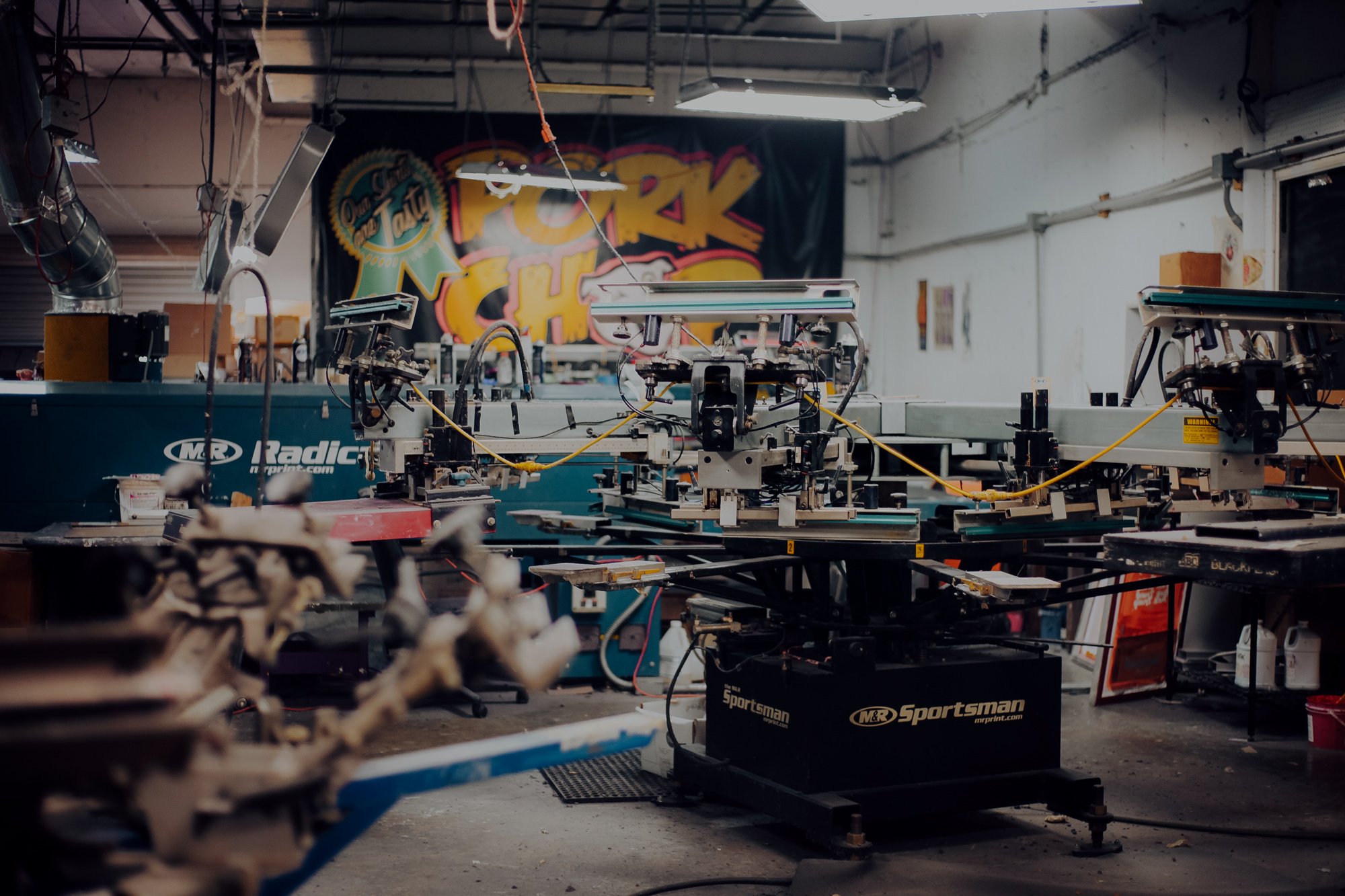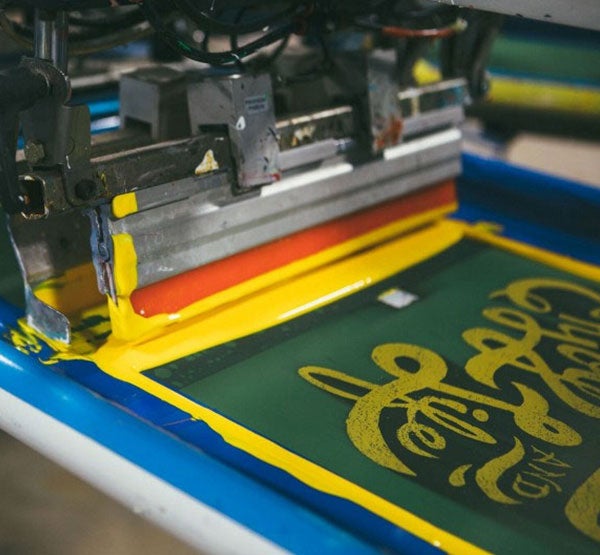High-Quality Custom Screen Printing for Team Apparel
Wiki Article
Screen Printing Uncovered: Whatever You Required to Understand About T-Shirt and Garment Printing Techniques
Display printing is a fascinating method that incorporates art with method, using unlimited opportunities for creativity. Prepared to check out the necessary components that make screen publishing an art form?
The Basics of Display Printing: Just How It Works
When you plunge right into screen printing, you'll uncover it's both an art and a scientific research. At its core, screen printing entails producing a stencil, or display, that allows ink to go through just in particular locations (screen printing kit). You begin by selecting your layout and preparing your display with a light-sensitive emulsion. When you expose this emulsion to light, it sets, leaving your style as a negative room.Placement the display over the material, after that make use of a squeegee to push ink with the display onto the garment. Each action is important, and mastering them will certainly elevate your display printing abilities, changing simple garments into special, meaningful items.
Kinds Of Screen Printing Methods
When you realize the essentials of display printing, it's time to discover the various techniques that can elevate your designs. One popular method is standard display printing, where ink is pressed through a stenciled screen.If you're aiming for great information, consider discharge printing. This technique removes dye from the material, leaving a soft, vintage appearance. Another option is plastisol printing, known for its toughness and dazzling colors, making it a preferred for numerous brands. Lastly, experiment with halftone printing to produce slope impacts and complex designs. Each method has its one-of-a-kind appeal, so do not think twice to attempt them bent on locate what suits your design best!
Vital Tools for Screen Printing
To attain sensational outcomes in display printing, having the appropriate tools is basic. You'll require a strong display printing framework, which holds the mesh that transfers your style onto the garment. Next, spend in premium mops; these are vital for using ink evenly across the screen.Picking the Right Inks and Products
When picking inks and materials for screen printing, you require to take into account the kind of ink that works ideal for your task. Consider textile compatibility to ensure your layouts look excellent and last long. Also, discover eco-friendly ink choices to make your printing procedure extra sustainable.Kinds Of Display Inks
Picking the best screen ink is essential for accomplishing vivid, durable prints that meet your job's requirements. There are numerous kinds of screen inks to analyze. Specialized inks, such as metal or glow-in-the-dark, can add unique impacts to your layouts.
Fabric Compatibility Factors To Consider
Comprehending fabric compatibility is essential for accomplishing premium screen prints, specifically considering that various products react distinctly to different inks. Constantly check your inks on sample fabric to assure they adhere properly and preserve shade integrity. In addition, keep in mind that material weight and appearance can affect the final result, so selecting the best ink and product combo is important for your job's success.Eco-Friendly Ink Options
Environment-friendly inks are becoming a prominent selection for screen printers who intend to minimize their ecological impact while maintaining top quality. When selecting inks, think about water-based inks, which are less dangerous and easier to tidy up contrasted to conventional solvents. These inks bond well with textiles, providing vivid results without poisonous chemicals. You might additionally explore eco-solvent inks that use fewer unstable natural substances (VOCs), making them a much safer choice for both your wellness and the earth.Furthermore, try to find inks made from eco-friendly sources, such as soy or vegetable-based alternatives. By choosing the best inks and materials, you'll not only produce sensational layouts yet additionally add to a more sustainable printing process. Make the switch, and your prints will reflect your dedication to the atmosphere!
Preparing Your Layout for Display Printing

Submit Format Requirements
To guarantee your layout looks sharp and vivid on material, you'll require to pay close interest to submit style requirements for display printing. Start with vector files like AI or EPS, as they can be scaled without losing high quality. If you utilize raster photos, opt for high-resolution files, such as TIFF or PNG, ideally at 300 DPI. Stay clear of using JPEGs, as they can lose clearness when resized. Make certain your layout has a transparent background to avoid unwanted white sides on your prints. Finally, keep color settings in mind; CMYK is conventional for display printing, so transform your RGB makes appropriately. By following these guidelines, you'll set your art work up for an effective print.Shade Splitting Up Techniques
Shade splitting up is a necessary step in preparing your design for display printing, and mastering it can substantially improve your print high quality. You'll require to damage your layout into specific shades, as each color calls for a separate display during printing. This accuracy not just ensures exact color depiction but likewise improves the printing procedure.Resolution and Dimension
Accomplishing the best lead to display printing starts with assuring your layout has the appropriate resolution and size. Ideally, your art work needs to be at least 300 DPI (dots per inch) for sharp, clear prints. Your last product might look amateur and pixelated. if you use lower resolution.When it involves size, consider the measurements of your print location. Layout your artwork to match the last print size, ideally creating it in the real dimensions you'll be printing. This method, you'll prevent any kind of unanticipated scaling problems.
Always inspect your design in both vector and raster formats. Vector graphics can be scaled without shedding top quality, making them excellent for screen printing. Preparing correctly will assure your layout looks incredible on every garment!
Step-by-Step Display Printing Refine
Display printing is a vibrant process that permits you to create lively styles on numerous surface areas. To start, you'll need a screen, solution, and your chosen ink. Initially, prepare your screen by cleaning it completely. Next, use the solution evenly and allow it completely dry in a dark area. Once dry, reveal your display to light with your style put on it, which will set the emulsion where the light hits, producing a stencil - screen printing kit.Pour ink onto the display and use a squeegee to push the ink with the pattern onto the material. Lift the screen carefully and let the print dry. You have actually successfully display published your layout.
Tips for Effective Screen Printing Projects
While you're diving into your screen printing jobs, keep in mind that prep work is crucial to success. Begin by gathering all your materials-- inks, mops, garments, and displays. A tidy workspace helps stop unwanted errors, so clean up prior to you begin.Next, validate your artwork is high-resolution and effectively sized for your garment. Test your display for proper direct exposure and tidy it extensively to custom screen printing avoid spots. When mixing your inks, follow the maker's standards to attain the ideal consistency.
Throughout printing, use even pressure with your squeegee for regular results. Do not hurry; take your time to confirm each print meets your criteria. After printing, allow your garments completely dry entirely before dealing with or packaging them.
Finally, constantly keep a sample of your work for future referral. By doing this, you can analyze your progression and improve your techniques with time. Pleased printing!

Regularly Asked Concerns
How much time Does It Require To Establish a Display Printing Work?
Establishing a screen printing job normally takes around thirty minutes to an hour. You'll prepare the displays, mix inks, and readjust journalism. The time differs based upon complexity and experience, so stay arranged!Can I Publish on Different Textile Types Utilizing the Exact Same Strategy?
Yes, you can publish on various material kinds using the very same technique, but you'll require to readjust your inks and settings. Some textiles absorb ink in a different way, so exploring assurances the very best outcomes for each product.What Prevail Mistakes to Avoid in Display Printing?
When display printing, avoid usual mistakes like utilizing the wrong ink, ignoring correct direct exposure times, or avoiding pre-press checks. Always check your configuration and maintain clean screens to ensure high quality results each time.Just How Can I Effectively Clean and Keep My Display Printing Equipment?
To correctly tidy and preserve your display printing equipment, you should frequently wash screens with suitable solvents, check squeegees for wear, and assure all devices are saved dust-free and dry. Consistency enhances and protects against pricey repairs efficiency.Is Display Printing Ecologically Friendly Contrasted to Other Techniques?
Screen printing can be extra eco-friendly than other techniques, especially if you make use of water-based inks and eco-conscious materials. By choosing sustainable products and methods, you decrease waste and reduce your impact on the earth.Screen Printing Uncovered: Everything You Need to Know Concerning T-Shirt and Garment Printing Strategies
At its core, display printing includes developing a pattern, or display, that enables ink to pass with only in specific locations. Placement the screen over the material, then use a squeegee to push ink with the display onto the garment. One preferred method is standard screen printing, where ink is pressed via a stenciled screen.When picking inks and products for display printing, you require to take right into account the type of ink that functions finest for your project.
Report this wiki page